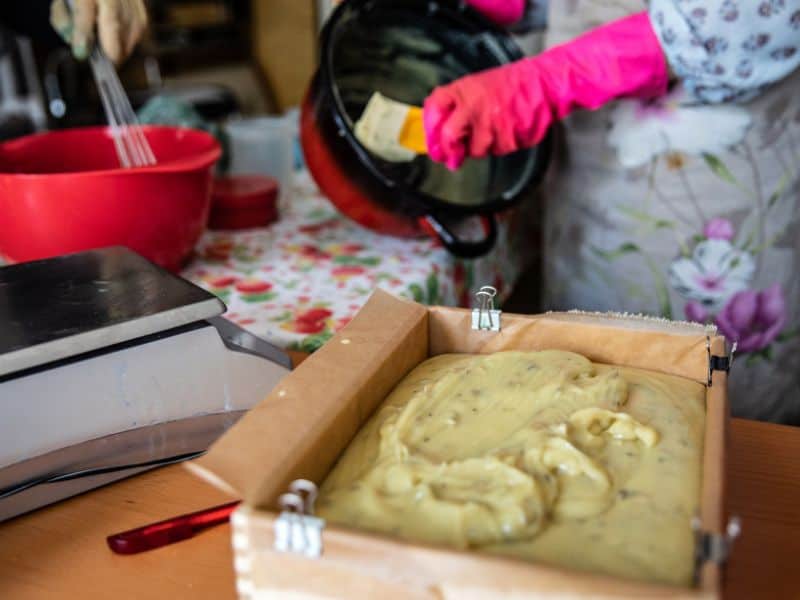Melt and pour soap is a great option for making homemade soap but sometimes you may need to reheat it. You might also want to heat up some of your scraps and combine them. That’s right – if you have leftover melted soap or want to create something new out of old scraps, there are several ways to do just that! In this blog post, we’ll explore how many times you can safely reheat melt, and pour soap as well as some tips on doing it correctly.
Melt and pour soap can be reheated approximately two times. Repeated reheating may lead to soap separation or deterioration of quality over time. It’s best to reheat the soap only when necessary and store it properly to ensure its quality and usability.
When reheating melt and pour soap, it’s important to use a double boiler or another indirect heat source. This helps to avoid burning the soap or having it scorch on the bottom of the container. Let’s look at some of the other factors associated with reheating melt and pour soap.
Factors to Consider Before Reheating
Reheating melt and pour soap can be a convenient way to fix mistakes or add additional ingredients, but there are some important factors to consider before doing so. These include the type of soap base used, the temperature of the soap, and the time lapse between the original melting and reheating.
Type of Soap Base Used
The type of soap base used will play a significant role in determining whether or not it is safe to reheat. Most melt and pour soap bases are designed to withstand reheating, but some may be more fragile than others.
For example, soap bases with added ingredients like goat’s milk or honey may become discolored or lose their scent if they are reheated too many times. It is important to check the manufacturer’s instructions or do some research before attempting to reheat a particular type of soap base.
Temperature of Soap
Another factor to consider is the temperature of the soap when reheating. It is important to avoid overheating the soap, as this can cause it to become brittle or lose its texture. The ideal temperature for reheating melt and pour soap is between 120 and 130 degrees Fahrenheit.
Using a candy thermometer can help ensure that the soap does not become too hot during the reheating process.
Time Lapse Between Original Melting and Reheating
The amount of time that has passed between the original melting and reheating of the soap can also affect its quality. Over time, the soap may begin to lose its texture or become brittle, making it more difficult to work with.
For best results, it is recommended to reheat the soap within a few weeks of its original melting. If more time has passed, it may be necessary to add additional ingredients or start with a fresh batch of soap.
Risks of Reheating Melt and Pour Soap
There are some risks involved that should be considered when reheating melt and pour soap. These include overheating, soap separation, and deterioration of quality.
Overheating
One of the biggest risks associated with reheating melt and pour soap is overheating. If the soap is heated to too high of a temperature or for too long, it can become brittle or lose its texture.
This can make it more difficult to work with and may even cause the soap to break apart. Additionally, overheated soap can be dangerous to work with, as it can cause burns or other injuries.
Soap Separation
Another risk of reheating melt and pour soap is soap separation. This can occur when the soap base is reheated too many times or is not heated evenly. When this happens, the soap may separate into different layers or clumps, making it difficult to work with.
To avoid this, it is important to heat the soap slowly and evenly, stirring frequently to ensure that it remains well-mixed.
Deterioration of Quality
Reheating melt and pour soap can also lead to a deterioration of quality over time. This is especially true if the soap is reheated multiple times or is stored for long periods of time.
Over time, the soap may begin to lose its texture, become brittle, or lose its scent. This can make it more difficult to work with and may even render it unusable.
Best Practices for Reheating Melt and Pour Soap
It is important to follow some best practices when reheating melt and pour soap to ensure the soap remains high quality and easy to work with.
Recommended Temperature Range
The ideal temperature range for reheating melt and pour soap is between 120 and 130 degrees Fahrenheit. This temperature range ensures that the soap remains pliable and easy to work with, while also minimizing the risk of overheating or scorching the soap.
Using a candy thermometer to monitor the temperature of the soap can be helpful in ensuring that the soap remains within this range.
Best Practices for Reheating
When reheating melt and pour soap, it is important to do so slowly and evenly. This can be achieved by heating the soap in short bursts in the microwave or by using a double boiler on the stove.
It is also important to stir the soap frequently to ensure that it remains well-mixed and to avoid overheating or soap separation. Once the soap has been reheated, it can be poured into a mold and allowed to cool and set before being used.
Alternative Methods for Reusing Soap
If you are looking for alternative methods for reusing soap, there are several options available. One option is to grate the soap and use it as a base for homemade laundry detergent or dish soap.
Another option is to melt down the soap and add it to a liquid soap base to create a customized liquid soap. These alternative methods can be a great way to make the most out of your soap scraps and reduce waste.
Quick Tips for Reheating Melt and Pour Soap
- Heat the soap slowly and evenly in short bursts, stirring frequently to avoid overheating or soap separation
- Use a candy thermometer to monitor the temperature of the soap, aiming for a range of 120-130 degrees Fahrenheit
- Be cautious of overheating, as it can cause the soap to become brittle and difficult to work with
- Consider alternative methods for reusing soap, such as grating it for homemade laundry detergent or adding it to a liquid soap base for customized liquid soap
- Once the soap has been reheated, pour it into a mold and allow it to cool and set before using it
- Store reheated soap in a cool, dry place and use it within a reasonable amount of time to avoid deterioration of quality over time
Frequently Asked Questions
The best way to reheat melt and pour soap is to do so slowly and evenly in short bursts, stirring frequently to ensure that the soap remains well-mixed and to avoid overheating or soap separation.
If melt and pour soap is reheated too many times or is stored for long periods of time, it may begin to lose its texture, become brittle, or lose its scent. This can make it more difficult to work with and may even render it unusable.
Melt and pour soap should be stored in a cool, dry place away from direct sunlight. Reheated soap should be used within a reasonable amount of time to avoid deterioration of quality over time.
If melt and pour soap is heated too hot, it can become brittle and difficult to work with. It is important to monitor the temperature of the soap while reheating and to use a candy thermometer if necessary.
Conclusion
In conclusion, reheating melt and pour soap is a great way to make the most out of your soap scraps and reduce waste. However, you should not reheat melt and pour soap anymore than two times or else you may risk damaging the soap base.
By following the tips outlined in this article, you can ensure that your reheated so remains pliable and easy to work with while also minimizing the risk of overheating or scorching it. With proper care and attention, you can enjoy multiple uses of your melt and pour soap scraps!






